Guest blogged by Steven Rosenfeld of AlterNet
The electronic voting problems in the 2008 election are broader than recently-publicized snafus such as machines not turning on, voter databases omitting names, or touch screens not properly recording votes, according to an analysis of 1,700 incident reports from the nation's largest voter hotline.
Moreover, the voting machine issues and the confusion they caused among poll workers appear to have compounded the delays faced by untold thousands of voters this fall, a preliminary analysis of 1-800-OUR-VOTE reports by Joseph Lorenzo Hall, a researcher at Princeton University and the University of California, has found...
"If we can do anything to improve the experience of the average voter facing a machine problem, it should be reduce the amount of time they spend in line," Hall wrote this week, adding that voters who had machine problems and got back-up paper ballots often were not confident that their votes would count.
"Another curious feature of the data is the voters' uniformly negative attitudes toward contingency or back-up plans," he said. "Voters are often upset and mistrustful."
Hall's analysis is one of the first assessments to look at electronic voting in the 2008 fall election. Many voting rights groups have said the biggest problems this year were inaccurate voter registration records, not enough early voting sites, and planning that did not accommodate high turnout. Hall's findings suggest that the voting machinery used exacerbated these very issues.
1700 Incident Reports
During early voting and on Election Day, the Election Protection Coalition, which had a volunteer staff of 10,000 lawyers, received calls via a national hotline, 1-866-OURVOTE. The calls were notated, categorized and posted on OurVoteLive.org. Of 86,000 calls received this fall, about 1,900 --- or 2.2 percent --- were about the machines. Two-thirds were registration and polling place inquiries.
There were 1,700 incidents after eliminating duplicates, Hall said. These calls generally did not involve problems encountered later Tuesday night during the vote count, he said in an e-mail. In contrast, the Democratic National Committee's election protection team monitoring machine issues, including the count, recorded "thousands" of incidents, a volunteer on that team said.
The most common voter hotline complaints were "about broken machinery, long lines, long waits to vote and reports of emergency ballots being used instead of the normal mode of voting," Hall said. "However, there are some interesting features from these reports."
Machine breakdowns and electronic poll book bottlenecks --- where voters check in before voting --- lead to many delays, Hall said. He cited a report from Atlanta where all 15 voting machines in a polling place had stopped working, and a New York City report of one poll book for hundreds of voters. A shortage of e-poll book laptops was reported in Georgia, while in Maryland poll workers could not get their electronic voting systems up and running, he said, citing typical complaints.
One surprise, Hall said, was that the delays in voting did not just come with checking in voters --- but with voters wanting to run their ballots through vote-count scanners. "We have reports of people waiting in line for 3 hours in New Jersey, 3.5 hours in Georgia, 5 hours in Ohio, 6 hours in Missouri," he said. "In many cases, long lines were exacerbated by voters insisting on feeding their own ballot into an optical scan machine, despite it taking a long time to service or replace the affected equipment."
Hall said he was "very encouraged to see that in most cases, emergency ballots were available," though he noted that in Virginia some precincts ran out of back-up ballots. "What I didn't count on was that voters consider voting via an emergency ballot to be fundamentally suspect; that is, most were worried that their vote wouldn't count if cast via emergency ballot."
Poll workers compounded this issue, he said, by confusing back-up and provisional ballots. The latter are used for unlisted voters and must be verified to count.
"We saw cases in at least two states where poll workers were refusing to hand out emergency ballots despite significant machine failures," he said referring to New York and Pennsylvania. "In one case a caller claimed that voters in line were "fighting with poll workers" over emergency ballots," he said. In addition, some voters were upset their vote was not secret because election officials could see their backup ballots.
It is impossible to know how many votes were affected by the issues cited in these incident reports. However, depending on the state and location, individual paperless voting machines could be used by 200 to 600 voters, and paper-ballot scanners could be used to count even larger numbers of ballots. While the presidential results would not appear to be undermined by any of these problems, they do reveal that machinery-related problems are more extensive than many people assume.
Machinery Still Unfamiliar
Hall's report noted other categories of voting machine issues. Since 2002, federal law has encouraged the use of paperless voting systems, especially for people with disabilities. However, Hall said "disability access equipment simply didn't work or was not set up properly" in Arizona, California, New York, Missouri, Minnesota and Maryland. He also noted a report of a poll worker not helping a blind voter because too many other voters were in line.
Machinery malfunctions were a common complaint, Hall said, saying New Jersey and Pennsylvania experienced "numerous reports of lights and buttons not working on machines." In addition, he said there were reports of machines that kept rebooting, "would work only after periodic shaking," or did not work with other computers in the network.
In 14 states, voters reported "vote flipping," where the machines selected another candidate other than their pick (FL, OH, PA, VA, GA, MD, MS, TX, NV, MO, NC, SC, IN, WV).
Voters raised the issue of who was authorized to fix broken machines. In South Carolina, "individuals removed a voting machine from the polling place and took it out to a car to tinker with it," Hall said. In New York, others, including a policeman, apparently "fixed" voting machines. Voters in Ohio and Pennsylvania also noted clocks on some machines were still set to Daylight Savings time, which prompted them to question whether their votes would count.
The process of paperless voting also confused some voters. "A 'fleeing voter' is a voter who leaves a voting machine without having cast their voted ballot," he said, citing incident reports from New Jersey, New York and Pennsylvania where that was an issue. "A 'premature voter' is one who accidentally casts their ballot (or has it cast for them) before they are finished voting their ballot," Hall said, citing reports from Ohio, Pennsylvania, Virginia, Florida and Chicago.
Straight-party voting or selecting candidates from one political party also had glitches, he said. In some instances, not all the candidates were selected, as in Washington, D.C. In Virginia and Pennsylvania, there were reports of ballots where the presidential race "was the only contest available," or the opposite, where the presidential race "was the only race missing."
Computer scanners that read paper ballots had other problems. Reports from Ohio, Virginia, Minnesota, Texas and North Carolina found counters on scanners did not record when new ballots were inserted, an issue that raised concerns about vote count accuracy. In Ohio, Missouri, Illinois and California, printers attached to paperless voting machines to create a paper record of electronic votes failed. In Virginia, scanners could not read wet or humid paper ballots. In Florida and California, using the wrong kind of pen caused votes to be misread, the incident reports said.
Poll workers also were confused with how to handle back-up paper ballots, Hall said. In California, New York and Pennsylvania, it was not clear where to put these ballots after people voted, he said. Some security seals on boxes were broken, he said, and in some cases ballots were "just laying around" or "stacked on top of machines," as was the case in Minnesota.
"In a few cases, poll workers intentionally or mistakenly cast a voter's ballot before they are finished voting or before they've had a chance to revise their ballot," Hall said, citing examples from New York, Virginia, Illinois and Arizona.
===
Steve Rosenfeld is a senior fellow at Alternet.org and author of several books, including "Count My Vote: A Citizen's Guide to Voting" and "What Happened in Ohio: A Documentary Record of Theft and Fraud in the 2004 Election".


 Judge Dismisses Long-Running Challenge to GA's Unverifiable, Insecure E-Vote System: 'BradCast' 4/1/25
Judge Dismisses Long-Running Challenge to GA's Unverifiable, Insecure E-Vote System: 'BradCast' 4/1/25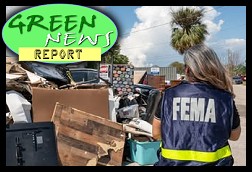 'Green News Report' 4/1/25
'Green News Report' 4/1/25
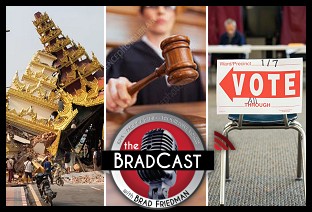 Bad Court and Election News for Trump is Good News for America: 'BradCast' 3/31/25
Bad Court and Election News for Trump is Good News for America: 'BradCast' 3/31/25 Sunday 'Great Start!' Toons
Sunday 'Great Start!' Toons Vets Push Back at Trump, Musk Plan to Slash Health Care, 80K V.A. Jobs: 'BradCast' 3/27/25
Vets Push Back at Trump, Musk Plan to Slash Health Care, 80K V.A. Jobs: 'BradCast' 3/27/25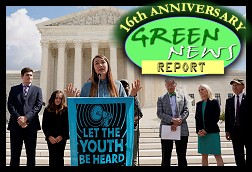 'Green News Report' 3/27/25
'Green News Report' 3/27/25 Signal Scandal Worsens for Trump, GOP; Big Dem Election Wins in PA: 'BradCast' 3/26
Signal Scandal Worsens for Trump, GOP; Big Dem Election Wins in PA: 'BradCast' 3/26 'Emptywheel' on Why Trump NatSec Team Should 'Resign in Disgrace' After Signal Chat Debacle: 'BradCast' 3/25/25
'Emptywheel' on Why Trump NatSec Team Should 'Resign in Disgrace' After Signal Chat Debacle: 'BradCast' 3/25/25 'Green News Report' 3/25/25
'Green News Report' 3/25/25 USPS 'Belongs to the People, Not the Billionaires': 'BradCast' 3/24/25
USPS 'Belongs to the People, Not the Billionaires': 'BradCast' 3/24/25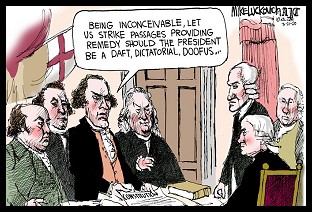 Sunday 'Suddenly Conceivable' Toons
Sunday 'Suddenly Conceivable' Toons 'Green News Report' 3/20/25
'Green News Report' 3/20/25 We're ALL Voice of America Now: 'BradCast' 3/20/25
We're ALL Voice of America Now: 'BradCast' 3/20/25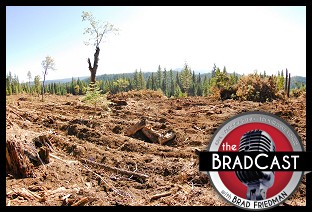 What Trump's 'Timber Production Expansion' Means (and Costs): 'BradCast' 3/19/25
What Trump's 'Timber Production Expansion' Means (and Costs): 'BradCast' 3/19/25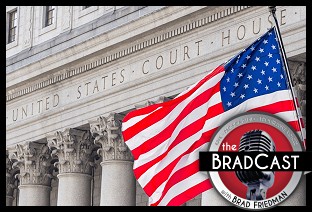 Courts Largely Holding Against Trump, Musk Lawlessness: 'BradCast' 3/18/25
Courts Largely Holding Against Trump, Musk Lawlessness: 'BradCast' 3/18/25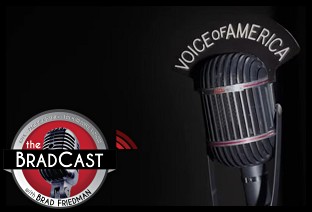 Chief VOA Reporter on Outlet Falling Silent First Time Since 1942: 'BradCast' 3/17/25
Chief VOA Reporter on Outlet Falling Silent First Time Since 1942: 'BradCast' 3/17/25 Trump EPA Unveils Plans to Endanger, Sicken Americans: 'BradCast' 3/13/25
Trump EPA Unveils Plans to Endanger, Sicken Americans: 'BradCast' 3/13/25 Trump Nixed Enforce-ment Against 100 Corp. Lawbreakers: 'BradCast' 3/12/25
Trump Nixed Enforce-ment Against 100 Corp. Lawbreakers: 'BradCast' 3/12/25 Bad Day for 'Strongmen': 'BradCast' 3/11
Bad Day for 'Strongmen': 'BradCast' 3/11 WI Election Could Flip Supreme Court Control, Musk Jumps In: 'BradCast' 3/10
WI Election Could Flip Supreme Court Control, Musk Jumps In: 'BradCast' 3/10
 VA GOP VOTER REG FRAUDSTER OFF HOOK
VA GOP VOTER REG FRAUDSTER OFF HOOK Criminal GOP Voter Registration Fraud Probe Expanding in VA
Criminal GOP Voter Registration Fraud Probe Expanding in VA DOJ PROBE SOUGHT AFTER VA ARREST
DOJ PROBE SOUGHT AFTER VA ARREST Arrest in VA: GOP Voter Reg Scandal Widens
Arrest in VA: GOP Voter Reg Scandal Widens ALL TOGETHER: ROVE, SPROUL, KOCHS, RNC
ALL TOGETHER: ROVE, SPROUL, KOCHS, RNC LATimes: RNC's 'Fired' Sproul Working for Repubs in 'as Many as 30 States'
LATimes: RNC's 'Fired' Sproul Working for Repubs in 'as Many as 30 States' 'Fired' Sproul Group 'Cloned', Still Working for Republicans in At Least 10 States
'Fired' Sproul Group 'Cloned', Still Working for Republicans in At Least 10 States FINALLY: FOX ON GOP REG FRAUD SCANDAL
FINALLY: FOX ON GOP REG FRAUD SCANDAL COLORADO FOLLOWS FLORIDA WITH GOP CRIMINAL INVESTIGATION
COLORADO FOLLOWS FLORIDA WITH GOP CRIMINAL INVESTIGATION CRIMINAL PROBE LAUNCHED INTO GOP VOTER REGISTRATION FRAUD SCANDAL IN FL
CRIMINAL PROBE LAUNCHED INTO GOP VOTER REGISTRATION FRAUD SCANDAL IN FL Brad Breaks PA Photo ID & GOP Registration Fraud Scandal News on Hartmann TV
Brad Breaks PA Photo ID & GOP Registration Fraud Scandal News on Hartmann TV  CAUGHT ON TAPE: COORDINATED NATIONWIDE GOP VOTER REG SCAM
CAUGHT ON TAPE: COORDINATED NATIONWIDE GOP VOTER REG SCAM CRIMINAL ELECTION FRAUD COMPLAINT FILED AGAINST GOP 'FRAUD' FIRM
CRIMINAL ELECTION FRAUD COMPLAINT FILED AGAINST GOP 'FRAUD' FIRM RICK SCOTT GETS ROLLED IN GOP REGISTRATION FRAUD SCANDAL
RICK SCOTT GETS ROLLED IN GOP REGISTRATION FRAUD SCANDAL VIDEO: Brad Breaks GOP Reg Fraud Scandal on Hartmann TV
VIDEO: Brad Breaks GOP Reg Fraud Scandal on Hartmann TV RNC FIRES NATIONAL VOTER REGISTRATION FIRM FOR FRAUD
RNC FIRES NATIONAL VOTER REGISTRATION FIRM FOR FRAUD EXCLUSIVE: Intvw w/ FL Official Who First Discovered GOP Reg Fraud
EXCLUSIVE: Intvw w/ FL Official Who First Discovered GOP Reg Fraud GOP REGISTRATION FRAUD FOUND IN FL
GOP REGISTRATION FRAUD FOUND IN FL


































